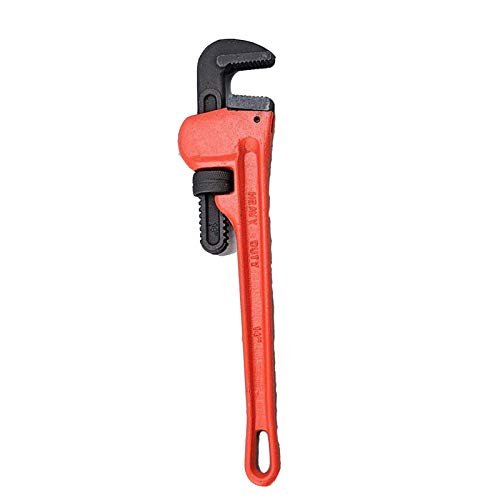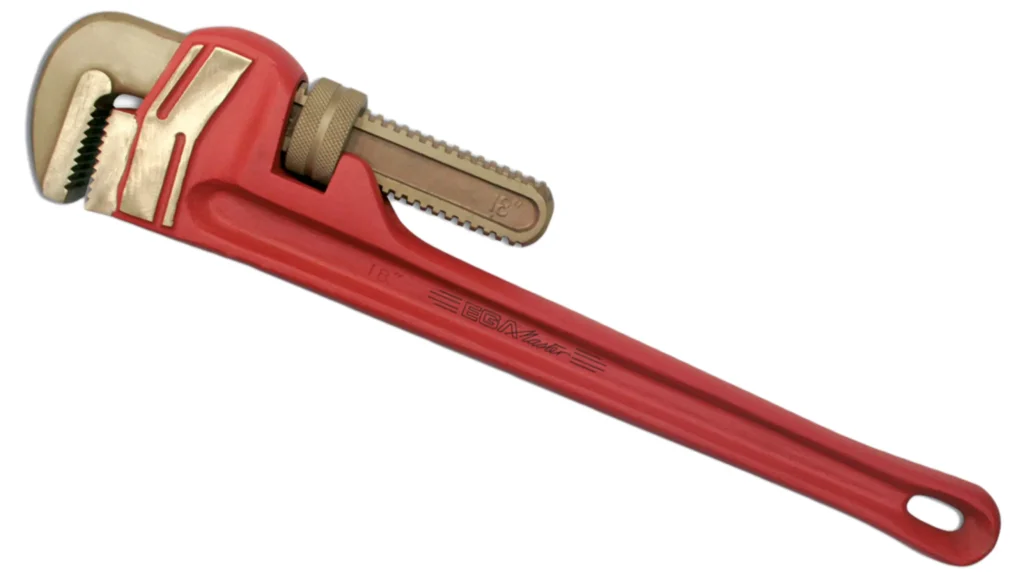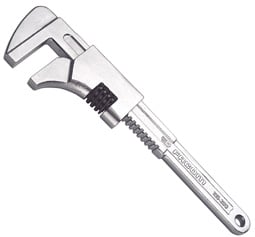A wrench is called a monkey wrench because it was invented by Charles Moncky. The name evolved from his last name.
The monkey wrench is a versatile and essential tool used in various mechanical tasks. It features an adjustable jaw, making it adaptable to different sizes of nuts and bolts. The tool’s invention dates back to the 19th century, attributed to Charles Moncky.
Its design allows for a strong grip and easy adjustments, making it a favorite among mechanics and DIY enthusiasts alike. Over time, the name “monkey wrench” stuck due to its association with Moncky, despite initial misunderstandings about its origin.
Today, it remains a staple in toolboxes around the world, known for its durability and functionality.
Origins Of The Monkey Wrench
The monkey wrench has a fascinating history. It is an important tool in many industries. Its unique name raises curiosity. Let’s explore its origins.

Credit: Amazon.com
Early Tool Development
Before the monkey wrench, people used simpler tools. Early tools were basic and often handmade. Blacksmiths crafted many of these primitive tools. They were essential for early construction and repairs.
The industrial revolution changed everything. Machines and factories needed better tools. New inventions were required to meet these needs. This era sparked the birth of the monkey wrench.
First Known Uses
The first known use of the monkey wrench dates back to the 19th century. Some say it was invented by Charles Moncky, a Baltimore mechanic. His name may have inspired the tool’s name.
Others believe the name comes from the tool’s adjustable jaws. These jaws resemble a monkey’s hand gripping an object. Regardless of the true origin, the tool became popular quickly.
The monkey wrench was useful in many fields. Plumbers, mechanics, and builders all used it. Its adjustable design made it versatile and reliable.
Today, the monkey wrench remains a common tool. Its origins may be debated, but its usefulness is clear.
Naming The Tool
The term “monkey wrench” often sparks curiosity. Why is it called that? The name has an interesting origin. Let’s explore how this tool got its unique name.
Etymology Of ‘monkey’
The word ‘monkey’ has a rich etymology. It dates back to the 16th century. Early uses referred to playful, small primates. But how does this connect to a wrench? Some suggest the tool’s adjustable nature. It mimics a monkey’s adaptability. Others believe it might come from ‘monkeying around’. This term means to tinker or adjust.
Historical References
In the 19th century, Charles Moncky was credited with inventing the tool. This is one popular theory. His name sounds like ‘monkey’, adding to the confusion. Another theory points to its use in railroad work. Workers often called it a ‘monkey wrench’. The term stuck, becoming widely accepted.
Let’s look at some key points in a table:
| Year | Event |
|---|---|
| 16th Century | First use of ‘monkey’ for primates |
| 19th Century | Charles Moncky credited with invention |
| 19th Century | Term used in railroad work |
These references highlight the tool’s evolving name. Each theory adds a piece to the puzzle. Understanding the name gives us insight into its history.
Innovations And Patents
The monkey wrench is an essential tool in many toolboxes. Its unique design has evolved through various innovations and patents. Understanding the history behind this tool can provide insight into its name and function.

Credit: sg.rs-online.com
Key Inventors
Several inventors contributed to the development of the monkey wrench. Some key names stand out in its history:
- Charles Moncky: Often credited with inventing the monkey wrench.
- Loring Coes: Another important figure, who improved the wrench’s design.
Notable Patents
Patents played a crucial role in the evolution of the monkey wrench. Here are some notable patents:
| Patent Number | Inventor | Year | Description |
|---|---|---|---|
| US 95,744 | Charles Moncky | 1869 | First patent for a wrench with adjustable jaws. |
| US 42,138 | Loring Coes | 1864 | Improved design for better grip and adjustment. |
These patents highlight the contributions of key inventors. They also show the importance of innovation in tool development.
Cultural Impact
The term monkey wrench has found a significant place in culture. This tool is not just a practical device but also a term with rich historical layers. These layers include references in pop culture and folklore.
Pop Culture References
In pop culture, the monkey wrench has appeared in various media. It has been featured in movies, TV shows, and cartoons. These appearances make the tool familiar even to those who don’t use it.
For example, in the 1930s, Popeye cartoons often showed the main character using a monkey wrench. It symbolized strength and ingenuity. Similarly, many comic strips and animated series have depicted characters wielding a monkey wrench.
The term also appears in music. The rock band Foo Fighters released a song titled “Monkey Wrench.” This song brought the term into the musical lexicon, introducing it to a new generation.
Folklore And Myths
Various myths surround the origin of the term monkey wrench. One popular story credits Charles Moncky as the inventor of the tool. This tale suggests the name “monkey wrench” is derived from his surname, Moncky. Yet, historical records do not support this claim.
Another myth involves the tool’s use by early American railroad workers. These workers supposedly found the wrench so versatile that they named it after their own nickname, “monkeys.”
Additionally, some folklore connects the term to the tool’s adjustable nature. The wrench’s ability to adapt to different sizes and shapes was likened to a monkey’s flexibility. This connection added a layer of meaning to the tool’s name.
These stories, though not always accurate, add to the cultural richness of the term. They illustrate how the monkey wrench has been woven into the fabric of everyday life and storytelling.
Comparisons With Other Wrenches
Understanding why a wrench is called a monkey wrench requires some comparisons. This section will compare the monkey wrench with other common wrenches.
Adjustable Wrenches
The adjustable wrench is versatile. It has a movable jaw, making it suitable for different sizes. Its design includes a screw mechanism. This mechanism allows for quick adjustments.
Unlike the monkey wrench, the adjustable wrench has a sleeker design. It is often lighter and easier to handle. The adjustable wrench is ideal for tight spaces. It fits snugly around nuts and bolts.
| Feature | Monkey Wrench | Adjustable Wrench |
|---|---|---|
| Design | Heavier and bulkier | Lighter and sleeker |
| Jaw Mechanism | Adjustable with a screw | Adjustable with a screw |
| Best Use | Heavy-duty tasks | Tight spaces |
Pipe Wrenches
The pipe wrench is designed for gripping round objects like pipes. Its jaws are serrated. This design helps in maintaining a firm grip. The pipe wrench is essential for plumbing tasks.
Comparing to a monkey wrench, the pipe wrench has a different jaw mechanism. The serrated jaws of a pipe wrench offer more grip. The monkey wrench, on the other hand, has smooth jaws. This makes it suitable for nuts and bolts.
- Pipe Wrench: Best for round objects
- Monkey Wrench: Ideal for nuts and bolts
Both tools have their unique applications. Choosing between them depends on the task at hand.

Credit: madison.com
Modern Usage
The monkey wrench remains an essential tool in many toolboxes. Despite evolving technology, its design has changed little. It’s still prized for its versatility and durability.
Current Applications
Today, the monkey wrench is used in various tasks. It is perfect for gripping and turning pipes and fittings. Its adjustable jaws make it suitable for different sizes of objects. People use it for plumbing, automotive repairs, and home maintenance.
Industries And Professions
The monkey wrench is indispensable in many industries. Below is a table showing its use in different professions:
| Industry | Profession | Usage |
|---|---|---|
| Construction | Plumbers | Gripping and turning pipes |
| Automotive | Mechanics | Loosening and tightening bolts |
| Manufacturing | Machine Operators | Adjusting machinery parts |
| Home Maintenance | DIY Enthusiasts | General repairs |
Each profession relies on the monkey wrench for different tasks. This tool is a must-have due to its flexibility and strength.
Common Misconceptions
Many people wonder why a wrench is called a monkey wrench. There are numerous misconceptions around its name. Some believe it has to do with monkeys using the tool. Others think it relates to the tool’s appearance. Let’s dive into these common misconceptions.
Myths Debunked
One popular myth is that the monkey wrench was named after monkeys. This is not true. Monkeys did not use this tool. Another myth is that the wrench looks like a monkey. This is also false. The wrench’s design does not resemble a monkey.
Some even say a person named Monkey invented the wrench. This is a common story, but it is incorrect. No inventor named Monkey existed in wrench history.
Clarifying Facts
The real story behind the name is much simpler. The wrench was originally called a “Moncky wrench”. It was named after its inventor, Charles Moncky. Over time, the name evolved into monkey wrench.
Moncky created the wrench to help with various tasks. It became popular because it was adjustable. This made it useful for many different jobs.
To sum it up, the name monkey wrench has nothing to do with actual monkeys. It is simply an evolution of the inventor’s name.
Credit: www.quora.com
Future Of The Monkey Wrench
The monkey wrench has been a staple in toolboxes for over a century. As technology evolves, so do the tools we use. The future of the monkey wrench looks bright and innovative.
Technological Advances
With the rise of smart technology, even simple tools like the monkey wrench are changing. Smart wrenches equipped with digital displays can show torque settings and angles. This makes tasks more precise and efficient.
Another advancement is the use of better materials. Modern monkey wrenches are made from lightweight, durable alloys. This makes them easier to use and longer-lasting.
3D printing is also revolutionizing tool manufacturing. Customizable and on-demand tools can now be printed as needed. This reduces waste and cuts down on storage space.
Evolution Of Tools
The monkey wrench has undergone significant changes over the years. From its basic design, it has evolved into a more ergonomic and versatile tool.
Early monkey wrenches were bulky and heavy. Modern designs focus on comfort and ease of use. Handles are now designed to reduce strain and improve grip.
Adjustable heads have also improved. New models offer finer adjustments and locking mechanisms. This ensures a secure grip on various fasteners.
In the future, we may see multi-functional tools that combine several functions into one. This could include features like built-in levels, rulers, or even sensors for detecting material types.
| Feature | Old Wrench | New Wrench |
|---|---|---|
| Material | Steel | Lightweight Alloy |
| Adjustability | Basic | Fine Adjustments |
| Ergonomics | Bulky | Comfort Grip |
The future of the monkey wrench is exciting. With new technologies and materials, it will become even more efficient and user-friendly.
Frequently Asked Questions
- What Is A Monkey Wrench?
A monkey wrench is an adjustable wrench used for turning nuts and bolts.
- Why Is It Called A Monkey Wrench?
It is believed to be named after Charles Moncky, who invented it.
- Who Invented The Monkey Wrench?
Charles Moncky, an American mechanic, is credited with its invention.
- How Does A Monkey Wrench Work?
The wrench adjusts to fit different sizes of nuts and bolts.
- When Was The Monkey Wrench Invented?
The monkey wrench was invented in the mid-19th century.
Conclusion
Understanding why a wrench is called a monkey wrench is fascinating. The name originates from its versatile, adjustable design.
This tool’s history and evolution reflect its importance in various fields. Next time you use one, you’ll appreciate its unique background.
Keep exploring everyday items for more intriguing stories.
Recent Posts
Maintaining clean gutters is essential for preventing water damage to your home, and choosing the best ladder for cleaning gutters can make the job much easier and safer. With so many options on the...
Best Ladder for Cleaning Caravan Roof: Top Picks for You Every Adventure!
Today we will discuss the best ladder for cleaning caravan roof. Cleaning caravan roofs is one of the crucial tasks.After many days, a caravan roof can get dirty by debris, dirt, and grime. These can...
